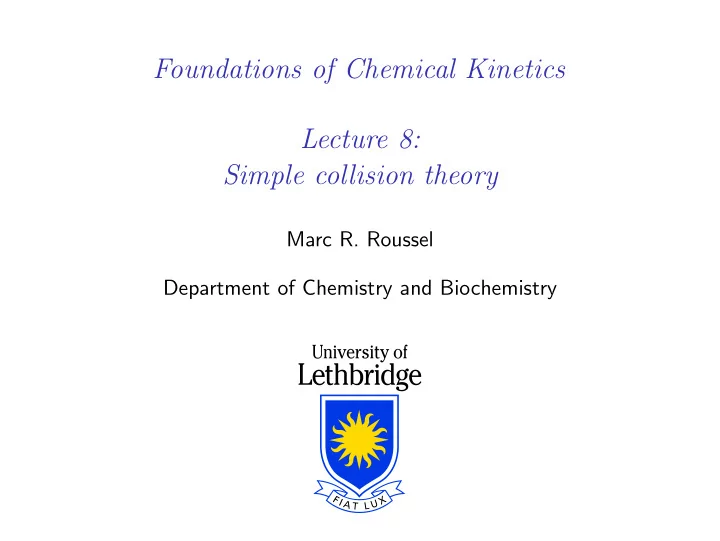

Foundations of Chemical Kinetics Lecture 8: Simple collision theory Marc R. Roussel Department of Chemistry and Biochemistry
Simple collision theory ◮ In a gas-phase bimolecular reaction, the reactants have to meet in order to react. ◮ A very simple theory of bimolecular reactions might assume that reaction just requires a meeting with sufficient energy. ◮ A Boltzmann-Arrhenius factor takes care of the energy requirement. ◮ The collisional rate constant should thus yield an estimate of the preexponential factor. ◮ Alternatively, the collisional rate constant could give an upper limit on the preexponential factor and/or highlight cases with anomalously large preexponential factors.
Rate of collision ◮ Assume spherical molecules A and B of radii r A and r B . Define r AB = r A + r B . ◮ Let n A and n B be the number of moles of A and B in the container. ◮ Imagine that the B molecules are stationary and focus on one A molecule. ◮ How many collisions with B molecules does A suffer per unit time?
Collision parameters Area σ r AB v A A B B σ : collision cross-section Number of collisions per unit time: number of B molecules whose centres lie within the volume swept out by the cross-section in unit time
Rate of collision (continued) ◮ Volume swept out by the cross-section per unit time: σ v A ◮ Number of B molecules per unit volume: n B L / V ◮ Number of B molecules crossing cross-section per unit time: ( σ v A )( n B L / V ) = σ v A n B L / V per molecule of A ◮ For n A L molecules, we get n A L ( σ v A n B L / V ) = σ v A n A n B L 2 / V collisions per unit time. ◮ To account for motion of B, replace v A by the mean relative speed ¯ v r . We want the rate of collisions per unit volume (since those are the usual units of rate of reaction), so divide by another factor of V . Rate of collisions: v r n A n B L 2 / V 2 Z AB = σ ¯
Mean relative speed � � 8 k B T 8 RT ¯ v r = = πµ πµ m 1 1 + 1 µ = m A m B 1 1 1 = + µ m M A M B
Collision theory rate constant ◮ Rate of reaction = (rate of collisions) × (Arrhenius factor) v r L 2 n A n B v = Z AB e − E a / RT = σ ¯ V 2 e − E a / RT ◮ [A] = n A / V and [B] = n B / V , so v r L 2 e − E a / RT [A][B] v = σ ¯ ◮ This rate is in molecules per unit volume per unit time. Divide by L to get the more customary units of moles per unit volume per unit time: v r Le − E a / RT [A][B] v = σ ¯
Collision theory rate constant (continued) v r Le − E a / RT [A][B] v = σ ¯ ◮ The rate is in the mass-action form for a bimolecular reaction with v r Le − E a / RT k ct = σ ¯ and A ct = σ ¯ v r L
A + A reactions ◮ For an A + A reaction, the method used above to count collisions would count every collision twice. ∴ A ct = 1 2 σ ¯ v r L ◮ Also note that in this case µ = m A / 2.
Example: 2 HI ( g ) → H 2 ( g ) + I 2 ( g ) Data: A = 10 11 L mol − 1 s − 1 , T = 500 K To do: Calculate cross-section assuming the reaction is collision-limited. µ m = M HI / 2 = 127 . 908 g mol − 1 2(1000 g kg − 1 ) = 6 . 3954 × 10 − 2 kg mol − 1 � 8(8 . 314 472 J K − 1 mol − 1 )(500 K) v r = ¯ = 407 m / s π (6 . 3954 × 10 − 2 kg / mol) 2(10 11 L mol − 1 s − 1 ) σ = 2 A v r L = (407 m / s)(6 . 022 142 × 10 23 mol − 1 )(1000 L m − 3 ) ¯ = 8 × 10 − 19 m 2
Example: 2 HI ( g ) → H 2 ( g ) + I 2 ( g ) (continued) ◮ Is this cross-section reasonable? ◮ Radius of the cross-section: σ = π r 2 AB σ/π = 5 × 10 − 10 m � ∴ r AB = ◮ Bond length in HI: 1 . 6092 × 10 − 10 m ◮ Is the reaction collision-limited?
Recommend
More recommend